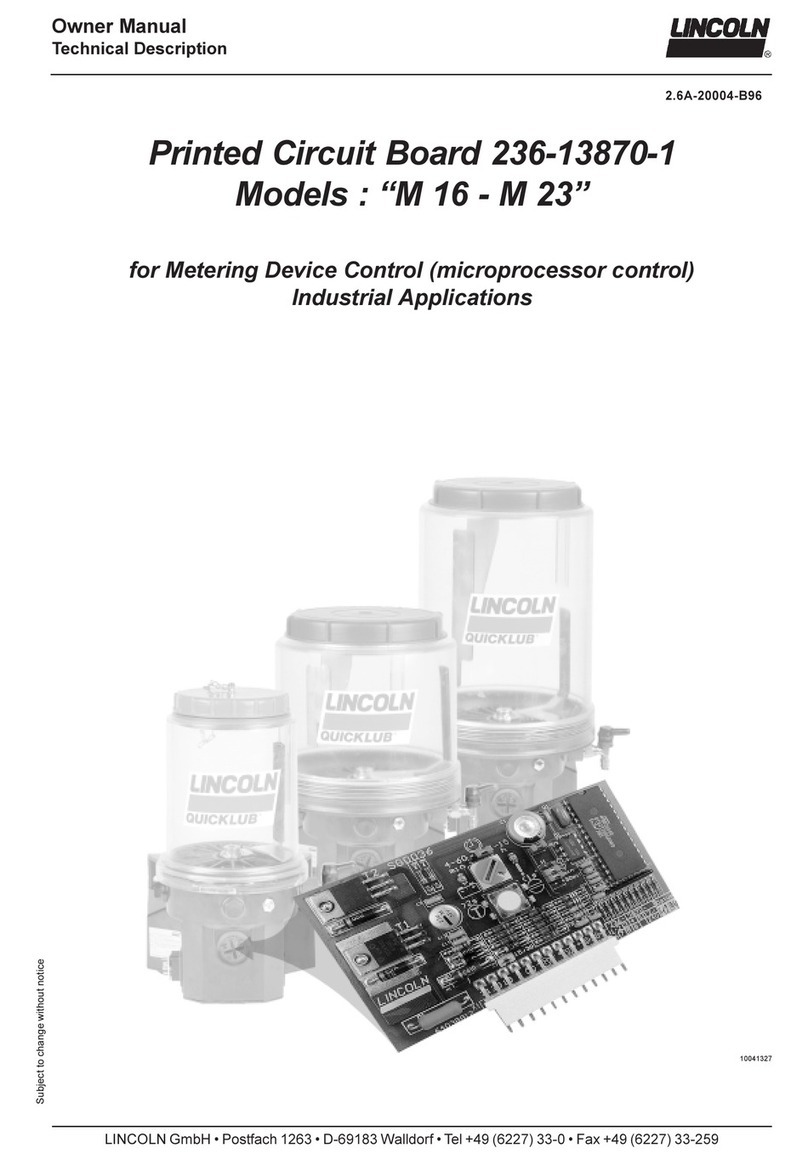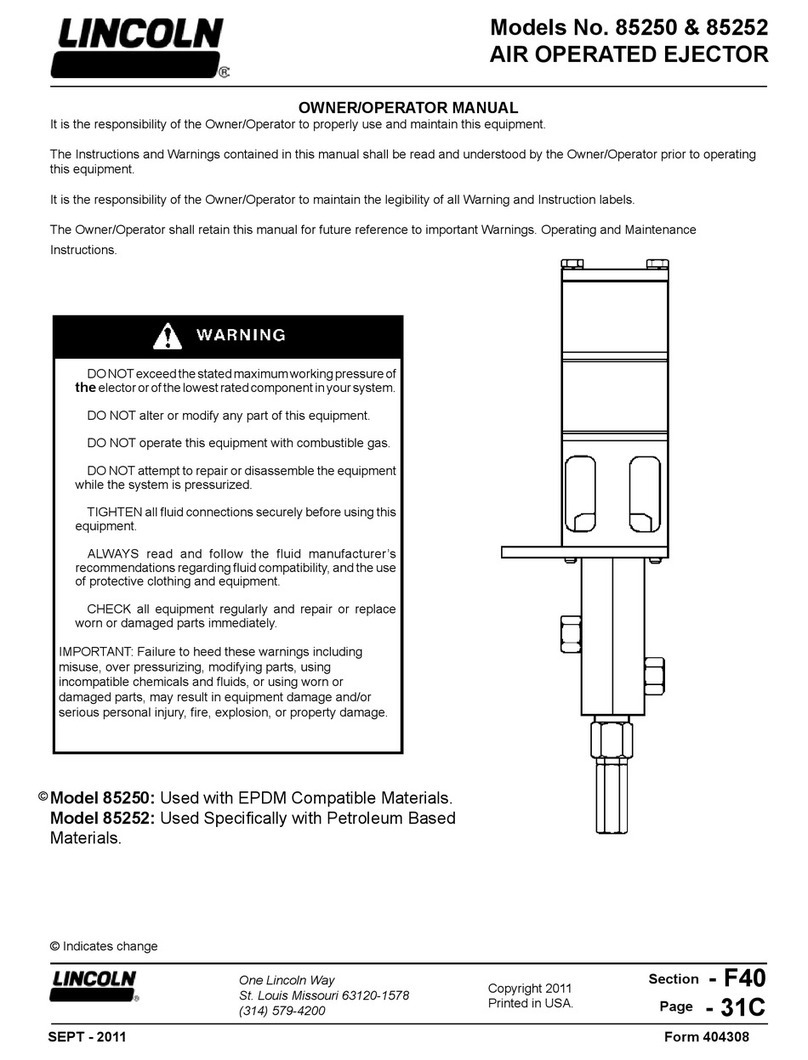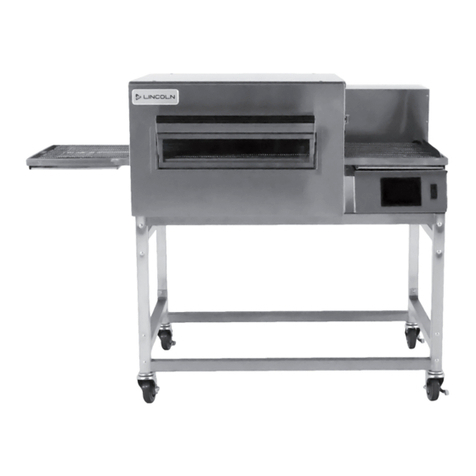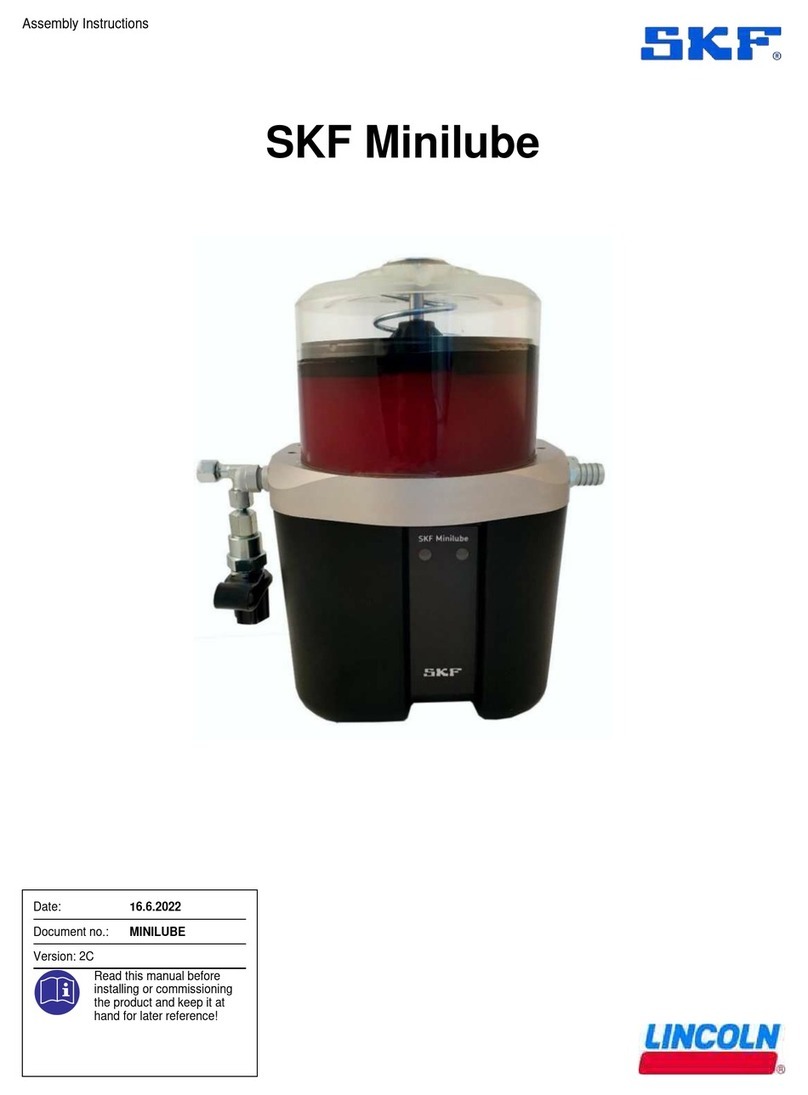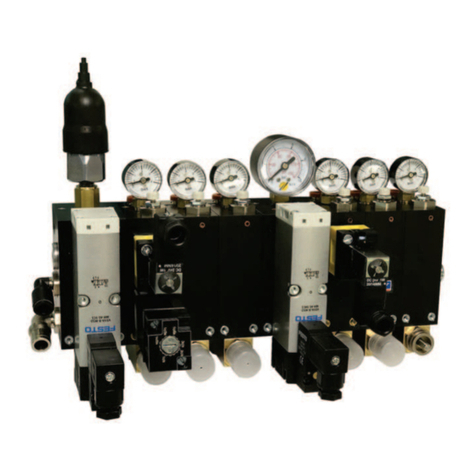Lincoln SKF VP Series User manual

EN
Progressive metering devices
of the series VP, VPK, VPB
951-230-008-EN
29/04/2021
Version 05
VP VPB
Component Lifecycle Manual
(CLM)

- 2 -
951-230-008-EN
Version 05
Masthead
EN
Training
SKF conducts detailed training in order to
enable the maximum safety and efficiency.
SKF recommends taking advantage of this
training. For information, contact the rel-
evant SKF service address.
Copyright
© Copyright SKF
All rights reserved.
Warranty
The instructions do not contain any informa-
tion on the warranty. This can be found in
our General Terms and Conditions.
Disclaimer of liability
The manufacturer shall not be held liable for
damage resulting from:
○Improper usage,
assembly, operation, configuration,
maintenance, repair, or accidents
○Improper reaction to malfunctions
○Unauthorized modifications to the
product
○Intentional or gross negligence
○Use of non-original
SKF spare components
The maximum liability for loss or damage
resulting from the use of our products is
limited to the purchase price. Liability for
indirect damage of any kind is excluded.
Masthead
Manufacturer
SKF Lubrication Systems Germany GmbH
Address of manufacturer plants
Headquarters
Walldorf Plant
Heinrich-Hertz-Str. 2-8
69190 Walldorf
Germany
Tel.: +49 (0) 6227 33-0
Fax: +49 (0) 6227 33-259
Berlin Plant
Motzener Straße 35/37
12277 Berlin
Germany
Tel. +49 (0)30 72002-0
Fax +49 (0)30 72002-111

- 3 -
951-230-008-EN
Version 05
EN
Table of contents
Table of contents
Explanation of symbols and signs 6
1. Safety instructions 8
1.1 General safety instructions 8
1.2 General behavior when handling
the product 8
1.3 Intended use 9
1.4 Foreseeable misuse 10
1.5 Painting plastic components 10
1.6 Modifications to the product 10
1.7 Prohibition of certain activities 10
1.8 Inspections prior to delivery 10
1.9 Referenced documents 11
1.10 Note on the type plate 11
1.11 Note on Pressure Equipment
Directive 2014/68/EU 11
1.12 Persons authorized to use the product 11
1.12.1 Operator 11
1.12.2 Qualified mechanic 12
1.12.3 Qualified electrician 12
1.13 Instruction of outside fitters 12
1.14 Provision of personal protective gear 12
1.15 Operation 12
1.16 Emergency shutdown 12
1.17 Transport, assembly, maintenance,
malfunction, repair, shutdown, disposal 12
1.18 First start-up, daily startup 14
1.19 Cleaning 14
1.20 Residual risks 15
2. Lubricants 16
2.1 General information 16
2.2 Selection of lubricants 16
2.3 Material compatibility 17
2.4 Aging of lubricants 17
3. Overview/functional description 18
3.1 Overview of progressive metering
devices 18
3.2 Information on volume data 18
3.3 Overview of a general
progressive system 20
3.3.1 Functional description of a general
progressive system 21
3.4 Overview of VP progressive metering
device series 22
3.4.1 Functioning of a VP progressive
metering device 24
3.5 Overview of VPK progressive
metering device series 26
3.5.1 Functioning of a VPK progressive
metering device 28
3.6 Overview of VPB progressive
metering device series 30
3.6.1 Functioning of a VPB progressive
metering device 32
3.7 Design and functional description
of piston detectors 33
3.7.1 Piston detector design 33
4. Technical data 34
4.1. Volume data for VP progressive
metering device sections 34
4.1.1 Basic design of VP progressive
metering device 34
4.1.2 VP progressive metering device
with piston detector 35
4.1.3 VPG progressive metering device
with 2/2 directional solenoid valve 35
4.1.4 VPG progressive metering device with
2/2 directional solenoid valve 36
4.1.5 VPG progressive metering device
with 4/2 or 3/2 directional
solenoid valve for oil, 36
4.1.6 VP progressive metering device
with flow limiter 37
4.2. Volume data for VPK progressive
metering device sections 38

- 4 -
951-230-008-EN
Version 05
EN Table of contents
4.2.1 Basic design of VPK progressive
metering device 38
4.2.2 VPK progressive metering device
with piston detector 39
4.2.3 VPK progressive metering device
with proximity switch 39
4.2.4 VPKG progressive metering device
with 2/2 directional solenoid valve 40
4.2.5 VPKG progressive metering device
with 2/2 directional solenoid valve 40
4.2.6 VPK progressive metering device with
4/2 and 3/2 directional solenoid valve 41
4.3. VPB volume data for progressive
metering device outlets 42
4.3.1 Basic design of VPB progressive
metering device 42
4.3.2 VPB progressive metering device
with piston detector 43
4.2.3 VPB progressive metering device
with proximity switch 43
4.3.3 VPB progressive metering device
with 2/2 directional solenoid valve 43
4.4 Piston detectors 44
5. Delivery, returns, and storage 46
5.1 Lubrication units 46
5.2 General notes 46
6. Assembly 47
6.1 General information 47
6.2 Installation information 47
6.2.1 Minimum mounting dimensions 48
6.3 VP port dimensions, assembly holes,
and minimum mounting dimensions 49
6.3.1 VP in basic design 49
6.3.2 VP tightening torques 50
6.3.3 VP with piston detector 51
6.3.4 VP progressive metering device
with cycle switch 51
6.3.5 VP progressive metering device
with flow limiter 52
6.3.6 VPG progressive metering device
with 2/2 directional solenoid valve 53
6.3.7 VP progressive metering device with
4/2 or 3/2 directional solenoid valve 53
6.3.8 VP progressive metering device with
2/2 directional solenoid valve 54
6.3.9 Assembly of the VP progressive
metering device 55
6.3.10 Changing VP progressive metering
device sections 56
6.3.11 Connecting outlets on the VPM 58
6.4 VPK in basic design 60
6.4.1 VPK tightening torques 61
6.4.2 VPK with piston detector 62
6.4.3 VPK progressive metering device
with cycle switch 62
6.4.4 VPK progressive metering device
with proximity switch 63
6.4.5 VPKG progressive metering device
with 2/2 directional solenoid valve 63
6.4.6 VPK progressive metering device with
4/2 or 3/2 directional solenoid valve 64
6.4.7 VPK progressive metering device with
2/2 directional solenoid valve 65
6.4.8 Assembly of the VPK progressive
metering device 66
6.4.9 Changing VPK progressive metering
device sections 67
6.4.10 Consolidation of multiple outlets
(crossporting) 69
6.5 VPB in basic design 73
6.5.1 VPB tightening torques 74
6.5.2 VPB with piston detector 75
6.5.3 VPB progressive metering device
with cycle switch 75
6.5.4 VPB progressive metering device
with 2/2 directional solenoid valve 76

- 5 -
951-230-008-EN
Version 05
EN
Table of contents
6.5.6 Consolidation of opposite outlets 78
6.5.7 Consolidation of multiple outlets
(crossporting) 78
6.6 Lubrication line connection 80
6.6.1 Mounting process 82
6.9 Lubrication line arrangement 84
6.10 Electrical connection 85
6.10.1 Connecting the inductive 85
6.10.2 Connecting directional solenoid valves 85
7. First start-up 86
7.1 Venting a grease progressive system 86
7.2 Venting an oil progressive system 87
7.3 Inspections before first start-up 88
7.4 Inspections during first start-up 88
8. Operation 89
9. Cleaning 89
9.1 Cleaning agents 89
9.2 Exterior cleaning 90
9.3 Interior cleaning 90
9.4 Cleaning the NAMUR sensor 90
10. Maintenance 91
10.1 General information 91
11. Malfunctions, causes, and remedies 92
11.1 Prior to beginning troubleshooting 92
11.2 Progressive metering device and
system malfunctions 93
12. Repairs 96
12.1 Replacing inductive NAMUR sensor 96
13. Shutdown and disposal 97
13.1 Temporary shutdown 97
13.2 Shutdown and disposal 97
14. Spare parts 98
14.1 Spare parts – VPG 98
14.2 Spare parts – VPK 107
14.3 Spare parts – VPB 114
15. Accessories 117
15.1 VPB bridge designs (crossporting) 117
15.2 VPB check valves 118
15.3 Cable sockets 119

- 6 -
951-230-008-EN
Version 05
EN
Symbols used
Meaning
Note
Electrical component hazard,
electric shock hazard
Slipping hazard
Hazard from hot components
Hazard from hot surface
Risk of being drawn into machinery
Crushing hazard
Danger from suspended load
Pressure injection hazard
Explosion-proof component
Electrostatic sensitive components
Wear personal safety equipment
(goggles)
Secure (lock) the closing device
against accidental starting of the
machine
Environmentally sound disposal
Explanation of symbols and signs
Explanation of symbols and signs
You will find these symbols, which warn of
specific dangers to persons, material assets,
or the environment, next to all safety in-
structions in these operating instructions.
Please heed these instructions and proceed
with special care in such cases. “Please for-
ward all safety instructions to other users.”
Information symbols within the text
Symbol Meaning
Prompts an action
Used for itemizing
Refers to other facts, causes, or consequences
Provides additional information within procedures
Warning level Consequence Probability
DANGER Death / serious injury Immediate
WARNING Death / serious injury Possible
CAUTION Minor injury Possible
IMPORTANT NOTE Property damage Possible
Symbol

- 7 -
951-230-008-EN
Version 05
EN
Instructions placed on a unit, machine, or
equipment, such as:
Rotation arrows
Fluid connection labels
must be followed and kept in fully legible
condition.
Read the component manual thoroughly
and follow the safety instructions.
Explanation of symbols and signs
Abbreviations and conversion factors
Abbreviations
re regarding oz. ounce
approx. approximately psi pound per square inch
°C degrees Celsius RH relative humidity
cu.in cubic inch s second
dB (A) sound pressure level sq.in. square inch
i.e. that is etc. et cetera
etc. et cetera e.g. for example
poss. possibly > greater than
°F degrees Fahrenheit < less than
fl.ou. fluid ounce ± plus or minus
fpsec feet per second Ø diameter
gal. gallon
if necessary if necessary Conversion factors
hp horsepower Length 1 mm 0.03937 inch
usually usually Area 1 cm² 0.155 sq.in.
in. inch Volume 1 ml 0.0352 fl.oz.
incl. including 1 l 2.11416 pints (US)
K Kelvin Mass 1 kg 2.205 lbs
kg kilogram 1 g 0.03527 oz.
kp kilopond Density 1 kg/cm³ 8.3454 lb./gal. (US)
kW kilowatt 1 kg/cm³ 0.03613 lb./cu.in.
l liter Force 1 N 0.10197 kp
lb. pound Speed 1 m/s 3.28084 fpsec.
max. maximum 1 m/s 2.23694 mph
min. minimum Acceleration 1 m/s² 3.28084 ft./s²
min minute Pressure 1 bar 14.5 psi
ml milliliter Temperature °C (°F-32) x 5/9
mm millimeter Power 1 kW 1.34109 hp
mph miles per hour
N Newton
Nm Newton meter

1. Safety instructions
1.1 General safety instructions
○The operator must ensure that the in-
structions are read by all persons tasked
with working on the product or who
supervise or instruct such persons. The
operator must also ensure that the staff
fully understands the content of the in-
structions. Putting the products into op-
eration or operating them without having
read the instructions is prohibited.
○Retain the instructions for further use.
○The products described here were
manufactured according to the state of
the art. Risks may, however, arise from
non-compliant usage and may result in
personal injury or damage to material
assets.
○Any malfunctions which may affect safety
must be remedied immediately. In ad-
dition to these instructions, the statu-
tory regulations for accident prevention
and environmental protection must be
observed.
1.2 General behavior when handling the product
○Responsibilities for different activities
must be clearly defined and observed.
Uncertainty seriously endangers safety.
○Protective and safety mechanisms must
not be removed, modified, nor disabled
during operation and must be checked
for proper function and completeness at
regular intervals.
○If protective and safety mechanisms
must be removed, they must be rein-
stalled immediately following conclusion
of work and then inspected for proper
function.
○Any malfunctions that occur must be
resolved according to responsibility. The
supervisor must be notified immediately
in case of malfunctions outside one's in-
dividual scope of responsibility.
○Never use any part of the centralized
lubrication system as a stand or step or
for climbing.
○The product may only be used in aware-
ness of the potential dangers, in proper
technical condition, and according to the
information in this manual.
○Familiarize yourself with the functions
and operation of the product. The speci-
fied assembly and operating steps and
their sequences must be observed.
○Any unclear points regarding proper
condition or correct assembly/operation
must be clarified. Operation is prohibited
until issues have been clarified.
○Unauthorized persons must be kept
away.
○Wear personal protective equipment.
○All safety regulations and in-house
instructions relevant to the particular
activity must be observed.
- 8 -
951-230-008-EN
Version 05
ENEN
1. Safety instructions

1. Safety instructions
1.3 Intended use
On VP and VPK progressive metering de-
vices, the number of cycles should be kept
as low as possible by selecting high-volume
progressive metering device sections. A
maximum value of 200 cycles/min should
not be exceeded. This also reduces pressure
losses and noise levels.
In case of an installation on moving machine
parts or in case of strong vibrations (e.g., on
pressing machines), the piston position of
the progressive metering device should not
correspond with the direction of movement
of the machine part.
VP, VPK, and VPB progressive metering de-
vices are classified as a component accord-
ing to the VDMA Position Paper “Umsetzung
der Maschinenrichtlinie 2006/42/EG in
Zentralschmiertechnik” (implementation of
the Machinery Directive 2006/42/EC in cen-
tralized lubrication systems).
Any other or additional usage of VP, VPK,
or VPB progressive metering devices is
deemed non-compliant with the intended
use and could result in damage, malfunc-
tion, or even injury.
The progressive metering devices are de-
signed for positively driven distribution of
lubricants (oils/greases) in a centralized
lubrication system.
The maximum inlet volumetric flow of the
progressive metering devices is as follows
Series:
VP 1000 cm3/min
VPK 500 cm3/min
VPB 400 cm3/min.
On all series, the maximum permissible op-
erating pressure for oil is 200 bar and 300
bar for grease.
The inlet and outlet fittings and their con-
necting lines must be designed for these
parameters.
The technical requirements for the instal-
lation of the VP, VPK, and VPB progressive
metering devices are set out in Chapter 6.
These requirements must be complied with.
The same applies to the technical data in
Chapter 4.
When designing a progressive metering
device, pay attention to the number of cycles
(strokes).
1
- 9 -
951-230-008-EN
Version 05
ENEN

1. Safety instructions
1.4 Foreseeable misuse
Any usage of the product other than as
specified in this manual is strictly prohibited.
Particularly prohibited are:
○Use outside the specified operating tem-
perature range
○Use of non-specified equipment
○Use without a pressure regulating valve
○Use in areas with aggressive, corrosive
substances (e.g., high ozone loads)
○Use in areas with damaging radiation
(e.g., ionizing radiation)
○Use to feed, forward, or store hazardous
substances and mixtures as defined in
Annex I Part 2-5 of the CLP Regulation
(EC 1272/2008) that are marked with
hazard pictograms
GHS01-GHS 09
○Use to feed / forward / store gases, lique-
fied gases, dissolved gases, vapors, or
fluids whose vapor pressure exceeds nor-
mal atmospheric pressure (1013 mbar)
by more than 0.5 bar at their maximum
permissible operating temperature
○Use in an explosion protection zone
1.5 Painting plastic components
The painting of all plastic components and
seals of the products described here is
prohibited.
Completely remove or mask affected compo-
nents before painting the main machine.
1.6 Modifications to the product
Unauthorized modifications and changes
can have an unpredictable effect on safety.
Unauthorized modifications and changes
are therefore prohibited.
1.7 Prohibition of certain activities
The following activities must be performed
only by employees of the manufacturer or
authorized persons due to possibly unde-
tectable sources of error or due to statutory
requirements:
1.8 Inspections prior to delivery
The following tests were performed prior to
delivery:
○Safety and functional tests
- 10 -
951-230-008-EN
Version 05
ENEN

1. Safety instructions
1.9 Referenced documents
In addition to this manual, the following
documents must be observed by the re-
spective target group:
○Operational instructions, approval rules
○The safety data sheet of the lubricant
used
If necessary:
○Project planning documents
○Instructions from suppliers of purchased
parts
○Instructions for other components for
setting up the centralized lubrication
system
○Other relevant documents for integration
of the product into the main machine,
system
1.11 Note on Pressure Equipment
Directive 2014/68/EU
Due to its performance characteristics, the
product does not reach the limit values
defined in Article 4, Paragraph 1, Subpara-
graph (a) item (i) and is, pursuant to Article
4, Paragraph 3, excluded from the scope of
Pressure Equipment Directive 2014/68/EU.
1.12 Persons authorized to use
the product
1.12.1 Operator
A person competent due to training, knowl-
edge, and experience to execute the func-
tions and activities associated with normal
operation; this also includes the avoidance
of possible hazards that may arise during
operation.
SKF Lubrication Systems Germany GmbH
VPK*-**-***
XYZ
KW/JJ
Made in Czech Republic
VPB*-*-***
KW/JJ
XYZ
SKF Lubrication Systems Germany GmbH
Made in Czech Republic
1.10 Note on the type plate
The type plate provides important data such
as the type designation, order number, etc.
To avoid loss of this data in case the type
plate becomes illegible, these characteristics
should be entered in the manual.
Type _______________________________
Serial No. ______________________
Date _________________
1
- 11 -
951-230-008-EN
Version 05
ENEN

1. Safety instructions
1.12.2 Qualified mechanic
A person with appropriate technical train-
ing, knowledge, and experience who can
recognize and avoid the hazards that may
occur during transport, assembly, first start-
up, operation, maintenance, repair, and
dismantling
1.12.3 Qualified electrician
A person with appropriate technical training,
knowledge, and experience who can recog-
nize and avoid hazards that may result from
electricity
1.13 Instruction of outside fitters
Before commencing work, the operator
must inform outside fitters of the opera-
tional safety regulations, applicable accident
prevention regulations, and the functions of
the main machine and its protective devices.
1.14 Provision of personal protective
gear
The operator must provide personal protec-
tive gear appropriate for the location and
intended application.
1.15 Operation
The following must be observed during first
start-up and operation:
○All information within this manual and
all information within the referenced
documents
○All laws and regulations that the operator
must observe
1.16 Emergency shutdown
Shut down the product in an emergency by:
○Switching off the main machine in which
the product is integrated
○If necessary, pressing the on/off switch on
the main machine
1.17 Transport, assembly, maintenance,
malfunction, repair, shutdown, disposal
○All relevant persons must be informed of
the activity prior to the start of this work.
Precautionary operational measures,
work instructions must be observed.
○Transport only with suitable transport
and lifting gear on suitable paths.
○Maintenance and repair work can be
subject to restrictions at low or high tem-
- 12 -
951-230-008-EN
Version 05
ENEN

1. Safety instructions
peratures (e.g., altered flow properties
of the lubricant). Maintenance and repair
work should therefore preferably be per-
formed at room temperature.
○Prior to performing work, the product
and the machine in which the product
will be integrated must be de-energized,
depressurized, and secured against un-
authorized activation.
○Take appropriate measures to ensure
that moving, detached parts are im-
mobilized during the work and that no
limbs can be pinched by unintended
movements.
○Assemble the product only outside the
operating range of moving parts, at an
adequate distance from sources of heat
or cold. Other units of the machine, the
vehicle must not be damaged or impaired
in their function by the installation.
○Dry any wet, slippery surfaces or cover
appropriately.
○Cover hot or cold surfaces appropriately.
○Work on electrical components may be
performed only by qualified electricians.
Note possible waiting times for discharge.
○Do not touch cables or electrical compo-
nents with wet or moist hands.
○Drill required holes only on non-critical,
non-load-bearing parts. Use existing
boreholes. Do not damage lines or cables
when drilling.
○
Observe any possible wearing spots. Pro-
tect components appropriately.
○All components used must be designed
for:
- The maximum operating pressure
- The maximum/minimum ambient
temperature.
○No parts may be subjected to torsion,
shear, or bending.
○Check parts for contamination before use
and clean if necessary.
○Lubrication piping should be filled with
lubricant prior to assembly. This simpli-
fies subsequent venting of the system.
○Adhere to the specified torques. Use
a calibrated torque wrench when
tightening.
○Avoid mixing up/incorrectly assembling
disassembled parts. Label parts.
1
- 13 -
951-230-008-EN
Version 05
ENEN

1. Safety instructions
1.18 First start-up, daily startup
Ensure that:
○All safety mechanisms are fully present
and functional.
○All connections are properly connected.
○All parts are correctly installed.
1.19 Cleaning
There is a fire hazard from the use of flam-
mable cleaning agents. Use only non-flam-
mable cleaning agents that are suitable for
the intended purpose.
○Do not use corrosive cleaning agents.
○Do not use steam-jet equipment or high-
pressure cleaners. This may damage
electrical components.
Observe the IP protection class.
○Mark wet areas accordingly.
- 14 -
951-230-008-EN
Version 05
ENEN

1. Safety instructions
1.20 Residual risks
Residual risk Possible in
lifecycle Avoidance / Remedy
Personal injury / property damage due to
falling of hoisted parts A, B, C, G, H, K Unauthorized persons must be kept away; nobody is allowed to be present below hoisted parts.
Personal injury/property damage due
to tilting or falling product due to non-
compliance with specified torques
B, C, G
Adhere to the specified torques. Secure the product only to components with a sufficient load-
carrying capacity. If no torques are specified, use those specified for the screw size for screws of
strength class 8.8.
Personal injury / property damage due to
spilled, leaked lubricant B, C, D, F, G, H, K
Be careful when connecting or disconnecting the lubricant piping. Use only hydraulic fittings
and lubrication piping suitable for the specified pressure. Do not install lubrication piping on
moving parts or wearing spots. If this cannot be avoided, use flexible hose lines or anti-kink
coils and/or conduits.
Lifecycles: A =Transport, B = Assembly, C = First start-up, D = Operation, E = Cleaning, F = Maintenance, G = Malfunction, repair,
H = Shutdown, K = Disposal
1
- 15 -
951-230-008-EN
Version 05
ENEN

2. Lubricants
2. Lubricants
2.1 General information
Lubricants are used specially for specific
applications. To fulfill the task, lubricants
must meet various requirements to varying
degrees. The most important requirements
for lubricants are:
○Reduction in friction and wear
○Corrosion protection
○Noise reduction
○Protection against contamination/
ingress of foreign matter
○Cooling (primarily for oils)
○Durability (physical/chemical stability)
○Compatible with as many materials as
possible
○Economic and environmental aspects
2.2 Selection of lubricants
SKF Lubrication Systems considers lubri-
cants to be an element of system design.
The selection of a suitable lubricant should
reasonably be made during the design of
the machine and forms the basis for plan-
ning the centralized lubrication system.
The manufacturer/operator of the machine
should preferably make the selection with
the supplier of the lubricant on the basis of
the requirements profile of the specific task.
If you have no or little experience selecting
lubricants for centralized lubrication sys-
tems, please contact SKF.
We gladly assist our customers in the selec-
tion of suitable components for feeding the
selected lubricant and in the planning and
design of a centralized lubrication system.
This will spare you potentially costly down-
time due to damage to the machine/system
and/or damage to the centralized lubrication
system.
Only lubricants specified for the
product may be used (see “Tech-
nical data” chapter). Unsuitable
lubricants may lead to failure of
the product.
Do not mix lubricants. This can
have unpredictable effects on the
usability and this function of the
centralized lubrication system.
- 16 -
951-230-008-EN
Version 05
EN

Due to the large number of pos-
sible additives, it is possible that
individual lubricants that meet
the required specifications ac-
cording to the manufacturer’s
data sheet are not suitable for
use in centralized lubrication
systems (e.g., incompatibility
between synthetic lubricants and
materials). To avoid this, always
use lubricants that have been
tested by SKF.
2.4 Aging of lubricants
In case of extended machine downtime,
check before re-commissioning that the
lubricant is still suitable for use in terms of
chemical and physical signs of aging. We
recommend performing this inspection after
one week of machine downtime.
In case of doubt regarding the suitability of
the lubricant, replace it before putting back
into operation and, if necessary, perform an
initial lubrication manually.
It is possible for lubricants to be tested in the
company's laboratory for their suitability for
pumping in centralized lubrication systems
(e.g., "bleeding").
Please contact SKF if you have further ques-
tions regarding lubricants.
An overview of the lubricants we have tested
is available on request.
2.3 Material compatibility
The lubricants must generally be compatible
with the following materials:
○Steel, gray cast iron, brass, copper,
aluminum
○NBR, FKM (FPM), ABS, PA, PU
2
- 17 -
951-230-008-EN
Version 05
EN
2. Lubricants

3. Overview/functional description
3. Overview/functional description
3.1 Overview of progressive metering devices
Figure 1 shows the VP, VPK, VPB, series of
SKF progressive metering devices with their
inlet volumetric flow data.
3.2 Information on volume data
In progressive metering devices, the nomi-
nal volume is indicated per stroke. This is
calculated from the piston diameter and the
maximum possible stroke of the particular
metering piston, the maximum stroke. The
maximum achievable piston capacity is typi-
cally used as the nominal volume when con-
figuring a progressive metering device,
though the movement of the piston is influ-
enced by various factors such as:
○Differences in back pressures at the
outlets, for example due to long tubing
lengths or connected roller bearings or
shaft bearings.
Fig. 1 Type and size
150
200
400
45
500
2500
1000
1200
700VP
VPK VPB
Q max. [cm³/min]
- 18 -
951-230-008-EN
Version 05
EN

3. Overview/functional description
○Stroke frequency (dynamics)
○Working temperature, viscosity fluctua-
tions due to strong temperature changes
The maximum stroke and thus the piston
capacity/metered quantity can reduce due to
these factors.
The minimum piston stroke, also referred
to as the compulsory stroke, is determined
by the position of the control bores in the
progressive metering device and the con-
trol edges on the metering piston. If only
the compulsory stroke is performed, the
metered quantity at the affected outlet is
reduced, which also increasing the effective
number of piston strokes. The theoretically
determined number of piston strokes can
therefore deviate from the actual mea-
sured value. This must be considered when
evaluating pulses on progressive metering
devices with a mounted piston detector.
The ratio of piston capacity per progres-
sive metering device outlet determines the Maximum stroke
Maximum stroke for piston 5/2 Compulsory stroke for position of piston 5/2
Compulsory stroke
distribution ratio of the quantity of lubricant
supplied to the progressive metering device.
This distribution ratio is usually constant
under all operating conditions.
Figure 2 shows the piston positions of a
progressive metering device section at
maximum stroke and at compulsory stroke
(minimum stroke).
red = control circuit
blue = working circuit
3
Fig. 2 Maximum stroke and compulsory stroke
5
5
25
5
2
- 19 -
951-230-008-EN
Version 05
EN

3. Overview/functional description
3.3 Overview of a general progressive system
1
2
3
max
8 9 10
2
4
6
7
5
1
3
5
Legend to Fig. 3
Progressive system with function
monitoring
1 Pump unit with:
Pressure regulating valve
- Control unit
- Fill level control
2 Main lubricant line
3 Main metering device (VP)
4 Function monitoring (piston detector)
5 Lubricant branch lines
6 Secondary metering device (VPK)
7 Lubrication point lines
8 External fault indicator light
9 External pump operation monitoring
10 Pushbutton for intermediate lubrication
6
Fig. 3 Example of progressive system with pump unit
- 20 -
951-230-008-EN
Version 05
EN
This manual suits for next models
10
Table of contents
Other Lincoln Industrial Equipment manuals
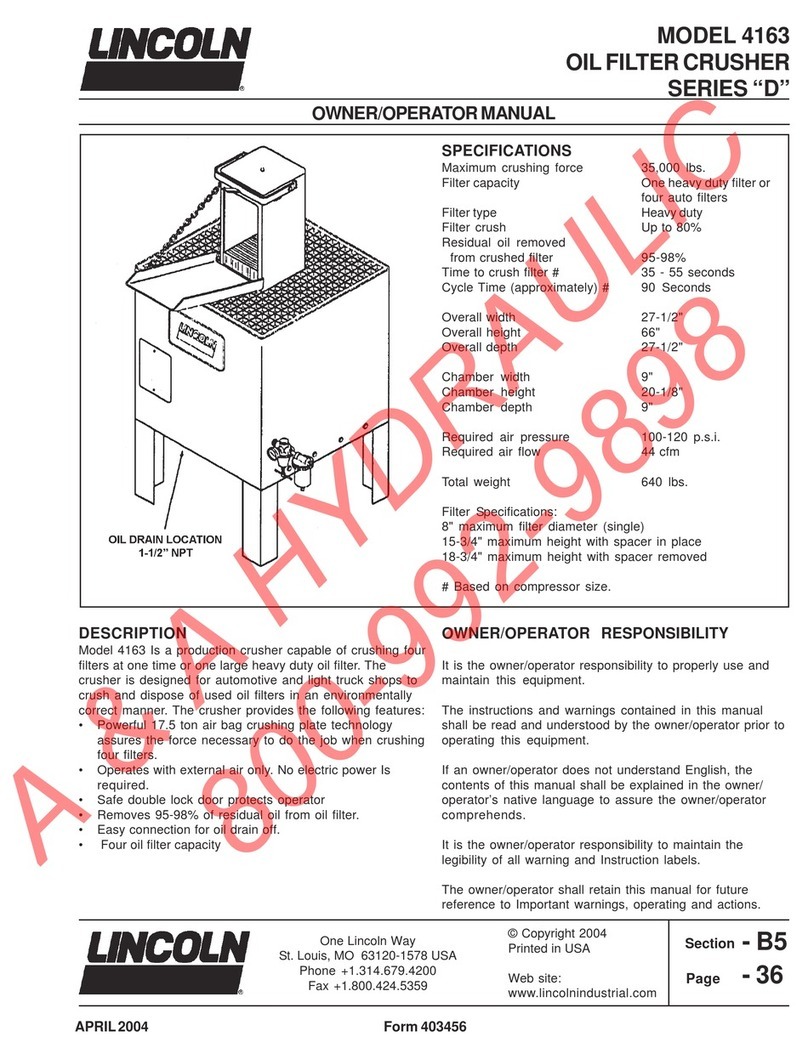
Lincoln
Lincoln D Series Owner's manual
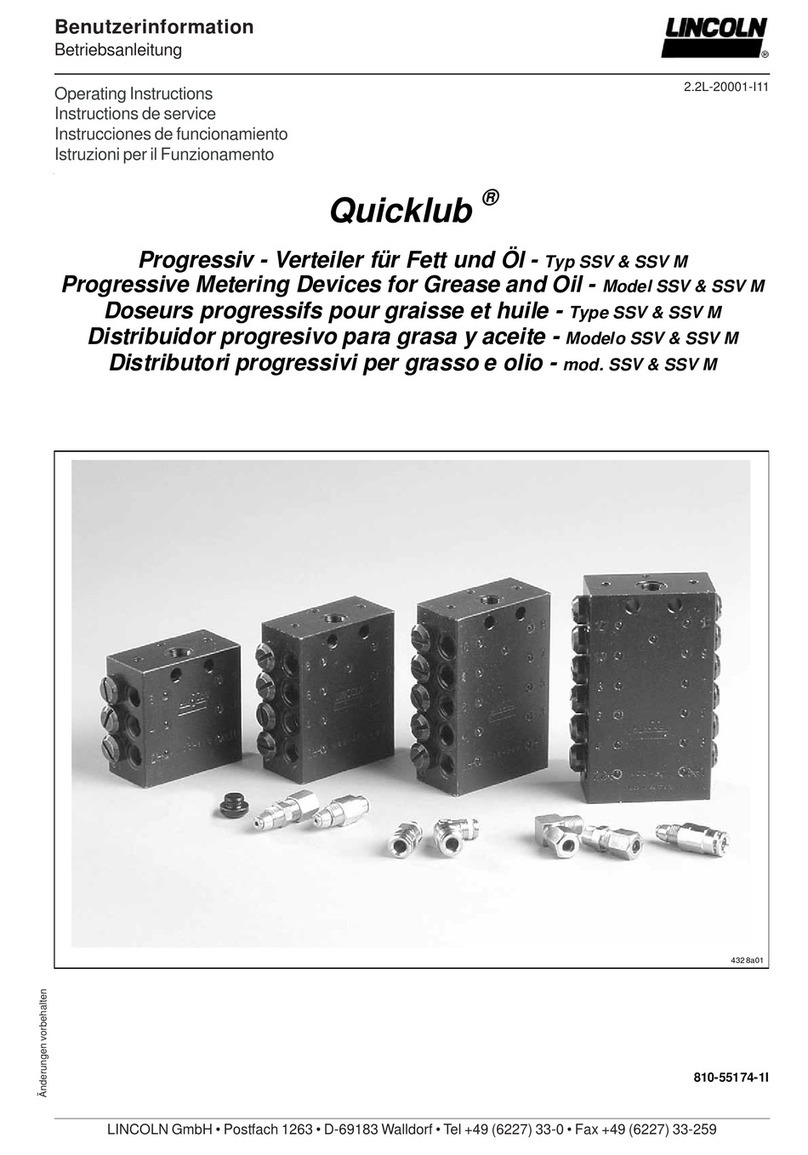
Lincoln
Lincoln Quicklub SSV User manual
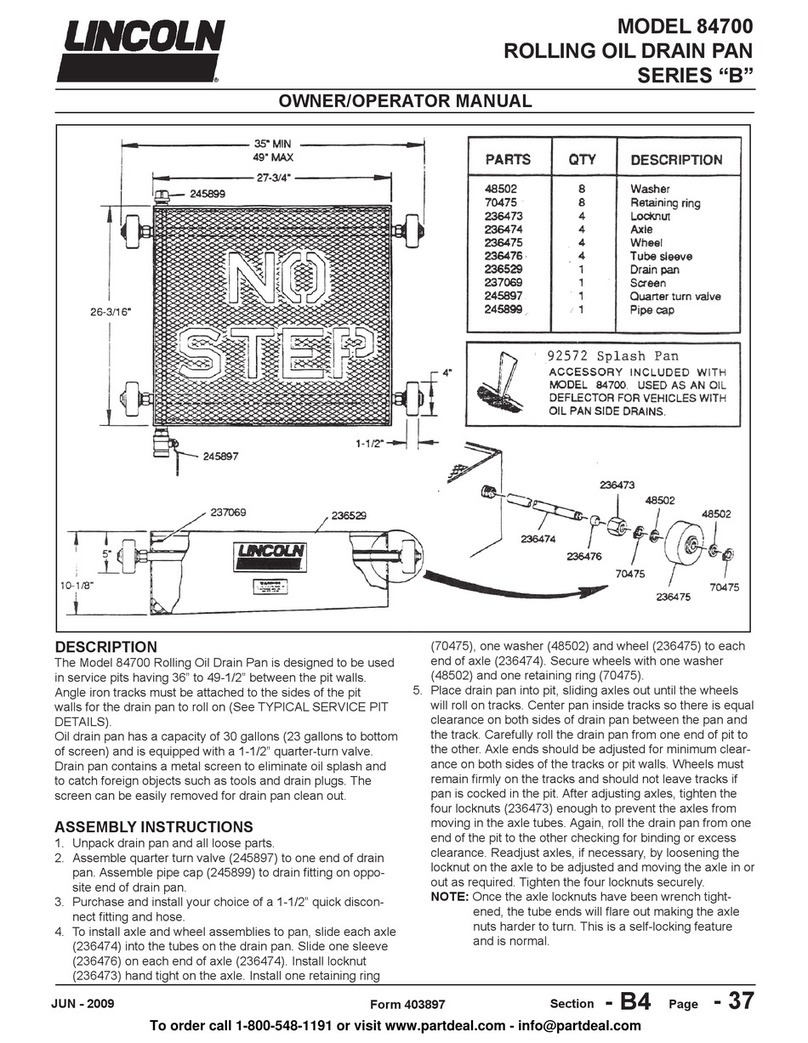
Lincoln
Lincoln 84700 Owner's manual
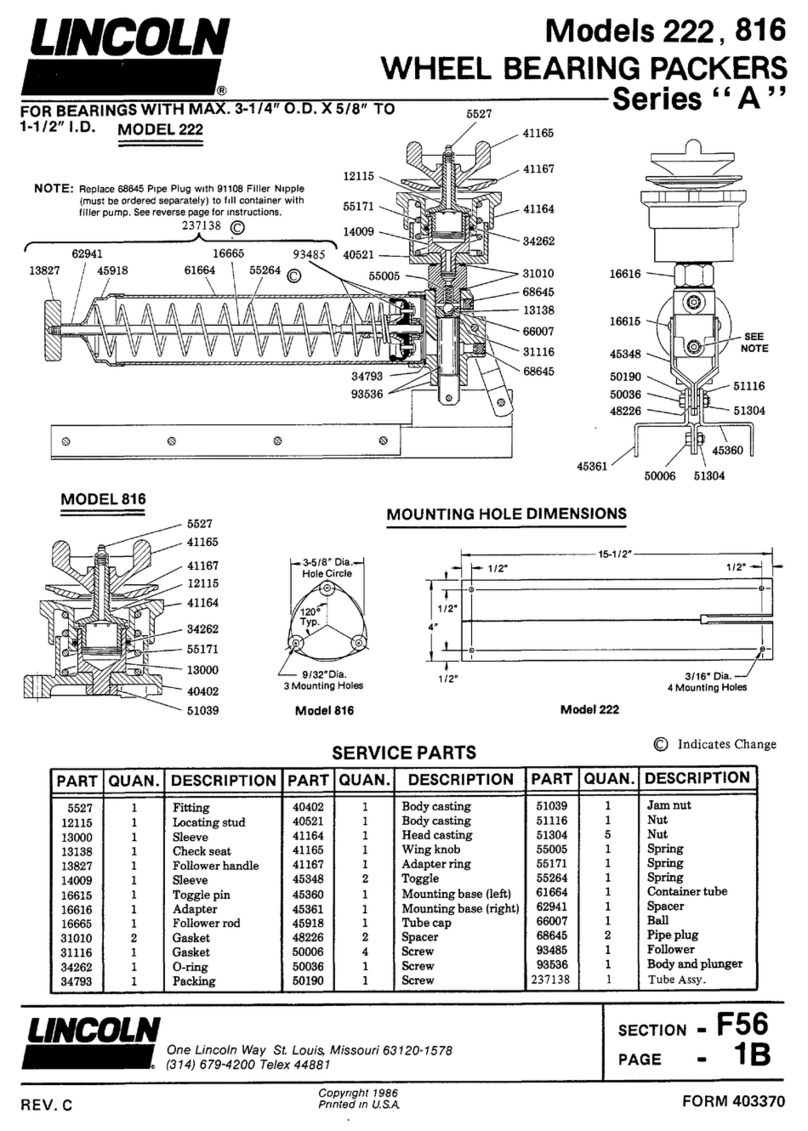
Lincoln
Lincoln A Series User manual
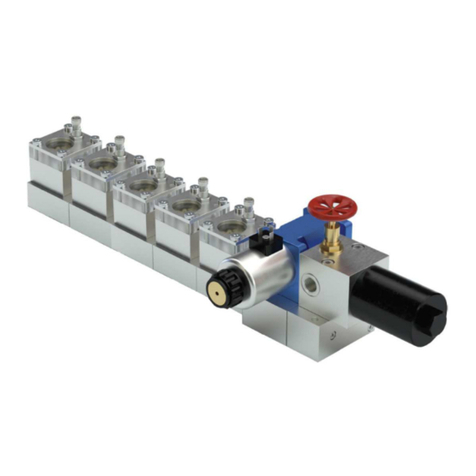
Lincoln
Lincoln SKF SMBM-X User manual

Lincoln
Lincoln Quicklub SSV User manual
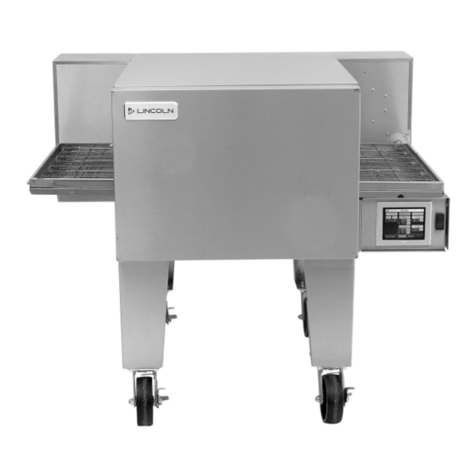
Lincoln
Lincoln Impinger Aperion 2424E User manual
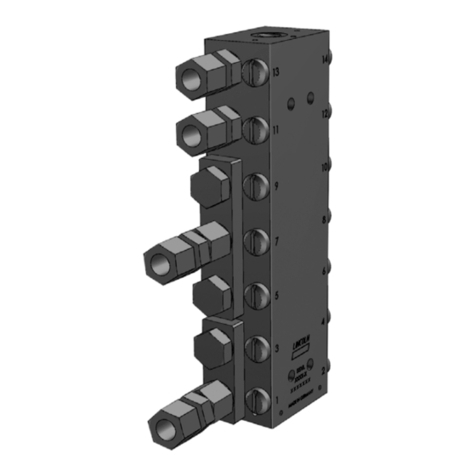
Lincoln
Lincoln Quicklub SSV L User manual
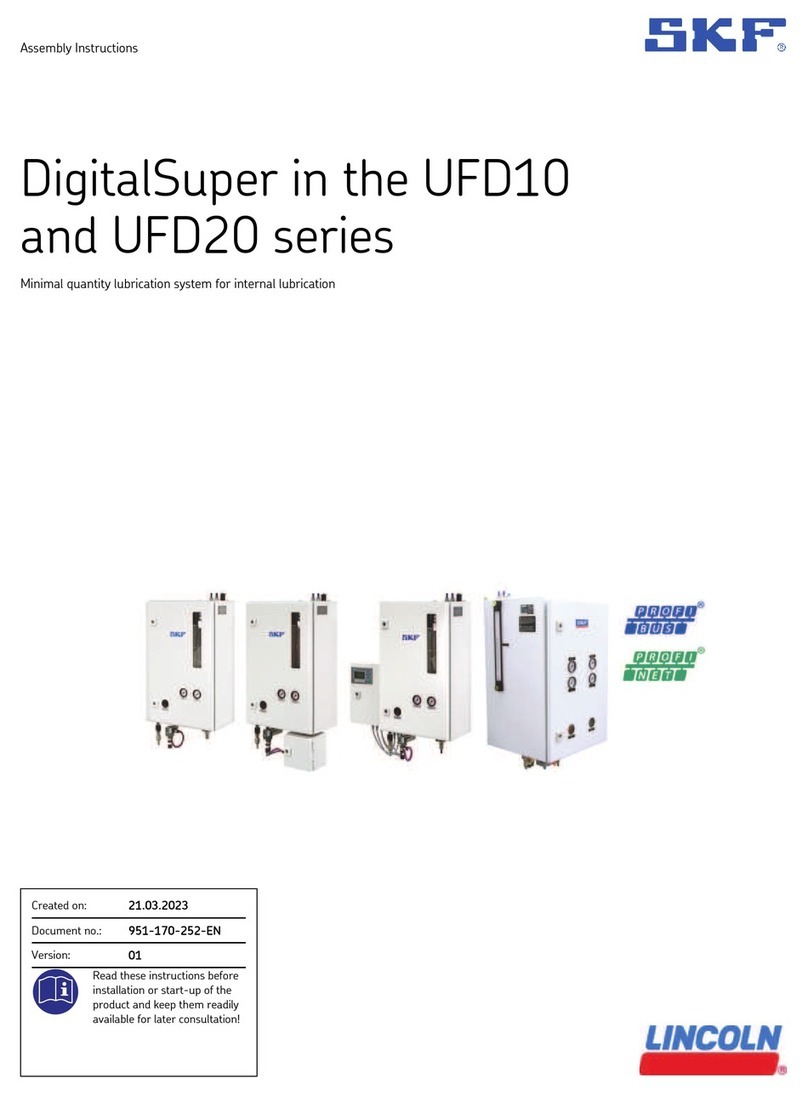
Lincoln
Lincoln SKF DigitalSuper UFD10 Series User manual
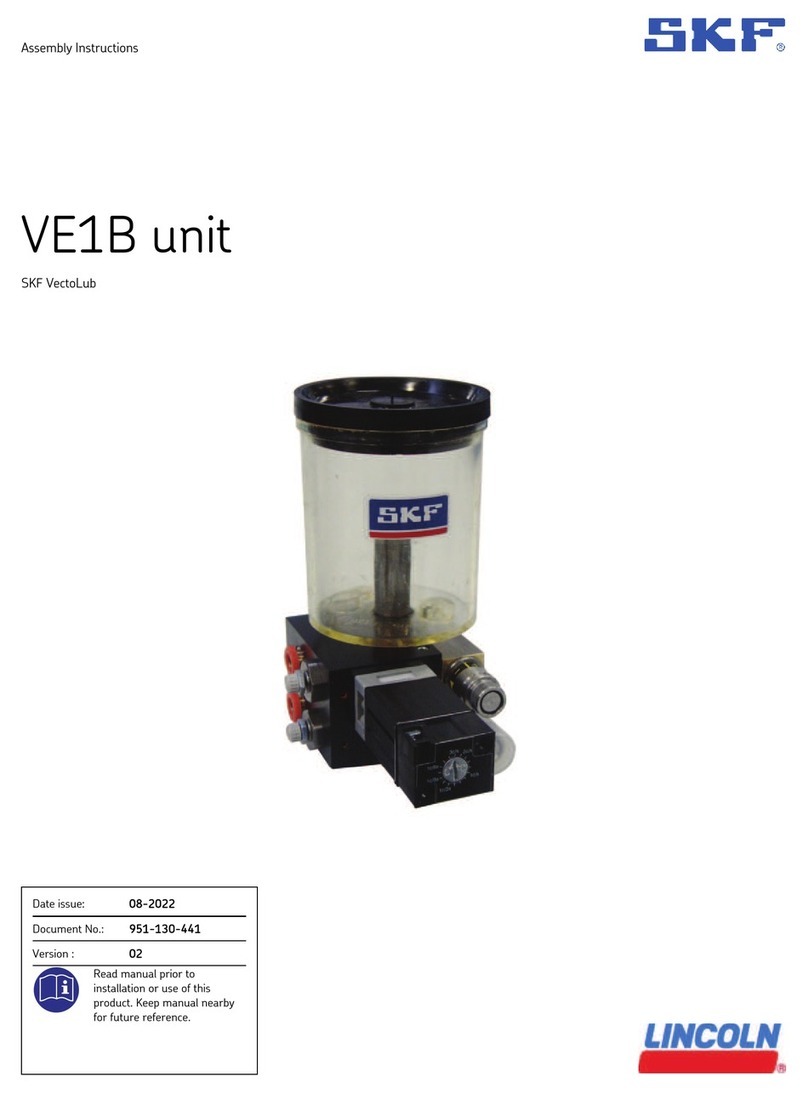
Lincoln
Lincoln SKF VectoLub VE1B unit User manual
